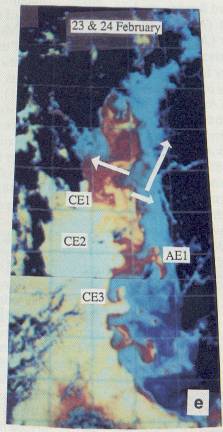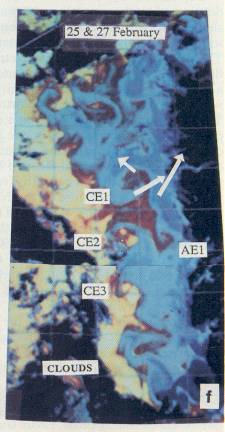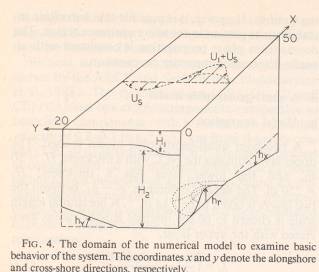Topic Area
Mesoscale
Meanders and Eddies in the Norwegian Coastal Current
Project Team Member
LT Charles Cutshaw, USN
Major Findings
The Norwegian Coastal Current (NCC) has similar to conditions off the coast
of Western Canada in that deep saline water is overlain with relatively
fresh glacial/river runoff.
› In
the case of the northward flowing NCC near the coast, the deep Atlantic
Water flows southward along the western side of a submerged canyon.
› Due
to gradual shoaling toward the south (Figure 2), the Atlantic Water turns
eastward until it hits the NCC.
› A
portion of the water is retroflected northward.
› This
effect adds relative vorticity to the NCC and the Atlantic Water.
› Conservation
of vorticity causes the NCC to develop cyclonic eddies. (See CE1 (Cyclonic
Eddy) in Figure1.)
› Causes
of eddies in the northern NCC are topographic steering, vortex stretching,
and barotropic instability.
In an attempt to model this environment a two-layer
quasi-geostrophic model was used.› The
upper layer was 50m deep and the lower layer was 250m deep. ›A
density difference of 1 kg/cm3 was assumed to exist between
the layers.››A
horizontal length scale (L) is assumed as the
upper layer internal Rossby radius.
The model side and bottom boundary conditions
were assumed to be free-slip. ›The
north and south boundary conditions were found to be unimportant to development
of the model eddies.› The variables
in the model runs were slope of the canyon floor (hx), slope
of the southern western canyon wall (hy), and the height of
the ridge (hr). (See Figure 3)› The
model was found to be very good simulation of overall conditions in the
NCC however some discrepancies were noted with eddy migration.›Inclusion
of friction may correct this.›Additionally,
the model showed that eddy formation in the southern NCC is due to baroclinic
instabilities and that the ridge is vital to re-establishing a žtypicalÓ
NCC flow pattern following a period of chaotic flow.


Figure 1. Location of front and formation of cyclonic eddy #1.

Figure 2. Bathymetry of canyon in area of Norwegian Coastal Current. |

Figure 3. Model of bathymetry of canyon. |
References
Johannessen,
J.A., E. Svendsen, S. Sandven, O.M. Johannessen, and K. Lygre, 1989: Three-dimensional
structure of mesoscale eddies in the Norwegian Coastal Current. J. Phys.
Oceanog., 19, 3-19.
Ikeda, M., J.A. Johannessen, K. Lygre, and S. Sandven, 1989: A process
study of mesoscale meanders and eddies in the Norwegian Coastal Current.
J.
Phys. Oceang., 19, 20-35.
Poulain, P.M., A. Warn-Varnas, and P.P. Niiler, 1996: Near-surface circulation
of the Nordic Seas as measured by Lagrangian drifters. J. Geophys. Res.,
101,
18237-18258.
.
| This is a government-maintained
internet site. Please read the U.S. Navy web page disclaimerand
the dislaimer regarding external
links. |
|





